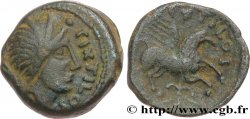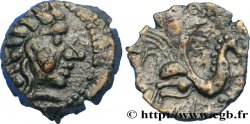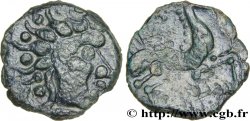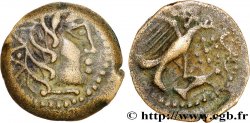bga_946268 - GALLIA - CARNUTES (Beauce area) Quart de statère d’or au loup conducteur
Not available.
Item sold on our e-shop (2024)
Price : 2 200.00 €
Item sold on our e-shop (2024)
Price : 2 200.00 €
Type : Quart de statère d’or au loup conducteur
Date: Ier siècle avant J.-C.
Mint name / Town : Chartres (28)
Metal : gold
Diameter : 12 mm
Orientation dies : 3 h.
Weight : 1,86 g.
Rarity : R3
Coments on the condition:
Monnaie centrée. Superbe revers, bien détaillé. Usure plus importante au droit. Patine de collection
Obverse
Obverse legend : ANÉPIGRAPHE.
Obverse description : Tête imitée de Philippe II, à droite ; la base du cou perlée.
Reverse
Reverse legend : ANÉPIGRAPHE.
Reverse description : Cheval harnaché à droite, loup (ou sanglier-aurige) sur la croupe ; petit aigle aux ailes éployées entre les jambes du cheval ; une ligne ondulée devant le cheval.
Commentary
Dans le Nouvel Atlas, cette monnaie est reprise sous la série "au loup conducteur".
Si aucun statère n’est connu, un hémi-statère a été récemment publié, élargissant cette série jusque là orpheline.
Si aucun statère n’est connu, un hémi-statère a été récemment publié, élargissant cette série jusque là orpheline.








 Report a mistake
Report a mistake Print the page
Print the page Share my selection
Share my selection Ask a question
Ask a question Consign / sell
Consign / sell
 Full data
Full data









